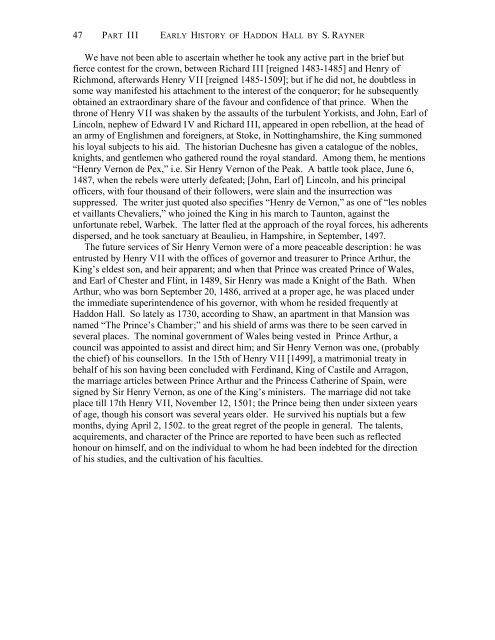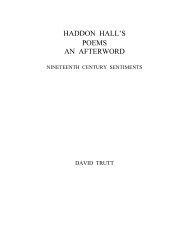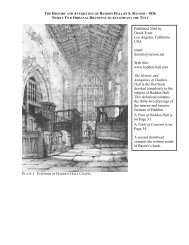Download - Haddon Hall
Download - Haddon Hall
Download - Haddon Hall
You also want an ePaper? Increase the reach of your titles
YUMPU automatically turns print PDFs into web optimized ePapers that Google loves.
47 PART III EARLY HISTORY OF HADDON HALL BY S. RAYNER<br />
We have not been able to ascertain whether he took any active part in the brief but<br />
fierce contest for the crown, between Richard III [reigned 1483-1485] and Henry of<br />
Richmond, afterwards Henry VII [reigned 1485-1509]; but if he did not, he doubtless in<br />
some way manifested his attachment to the interest of the conqueror; for he subsequently<br />
obtained an extraordinary share of the favour and confidence of that prince. When the<br />
throne of Henry VII was shaken by the assaults of the turbulent Yorkists, and John, Earl of<br />
Lincoln, nephew of Edward IV and Richard III, appeared in open rebellion, at the head of<br />
an army of Englishmen and foreigners, at Stoke, in Nottinghamshire, the King summoned<br />
his loyal subjects to his aid. The historian Duchesne has given a catalogue of the nobles,<br />
knights, and gentlemen who gathered round the royal standard. Among them, he mentions<br />
“Henry Vernon de Pex,” i.e. Sir Henry Vernon of the Peak. A battle took place, June 6,<br />
1487, when the rebels were utterly defeated; [John, Earl of] Lincoln, and his principal<br />
officers, with four thousand of their followers, were slain and the insurrection was<br />
suppressed. The writer just quoted also specifies “Henry de Vernon,” as one of “les nobles<br />
et vaillants Chevaliers,” who joined the King in his march to Taunton, against the<br />
unfortunate rebel, Warbek. The latter fled at the approach of the royal forces, his adherents<br />
dispersed, and he took sanctuary at Beaulieu, in Hampshire, in September, 1497.<br />
The future services of Sir Henry Vernon were of a more peaceable description: he was<br />
entrusted by Henry VII with the offices of governor and treasurer to Prince Arthur, the<br />
King’s eldest son, and heir apparent; and when that Prince was created Prince of Wales,<br />
and Earl of Chester and Flint, in 1489, Sir Henry was made a Knight of the Bath. When<br />
Arthur, who was born September 20, 1486, arrived at a proper age, he was placed under<br />
the immediate superintendence of his governor, with whom he resided frequently at<br />
<strong>Haddon</strong> <strong>Hall</strong>. So lately as 1730, according to Shaw, an apartment in that Mansion was<br />
named “The Prince’s Chamber;” and his shield of arms was there to be seen carved in<br />
several places. The nominal government of Wales being vested in Prince Arthur, a<br />
council was appointed to assist and direct him; and Sir Henry Vernon was one, (probably<br />
the chief) of his counsellors. In the 15th of Henry VII [1499], a matrimonial treaty in<br />
behalf of his son having been concluded with Ferdinand, King of Castile and Arragon,<br />
the marriage articles between Prince Arthur and the Princess Catherine of Spain, were<br />
signed by Sir Henry Vernon, as one of the King’s ministers. The marriage did not take<br />
place till 17th Henry VII, November 12, 1501; the Prince being then under sixteen years<br />
of age, though his consort was several years older. He survived his nuptials but a few<br />
months, dying April 2, 1502. to the great regret of the people in general. The talents,<br />
acquirements, and character of the Prince are reported to have been such as reflected<br />
honour on himself, and on the individual to whom he had been indebted for the direction<br />
of his studies, and the cultivation of his faculties.







